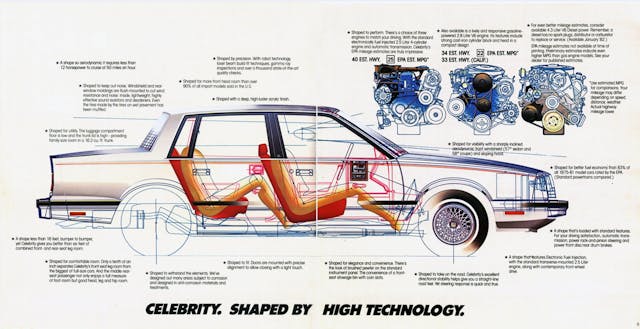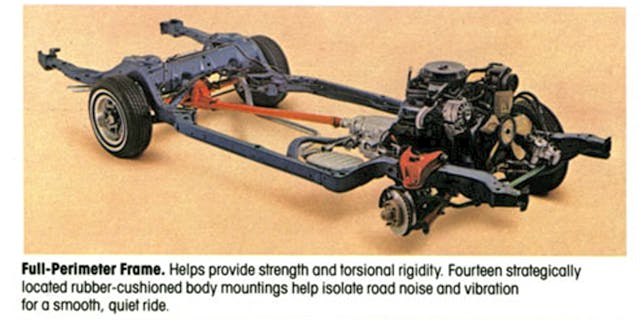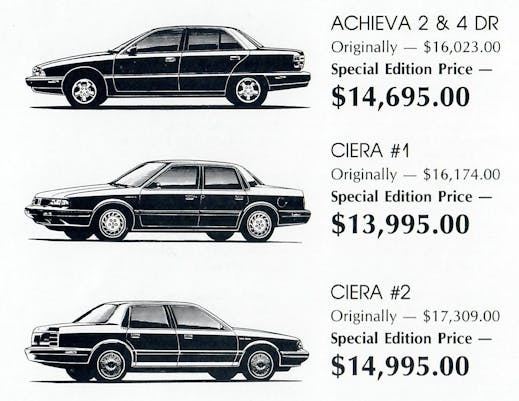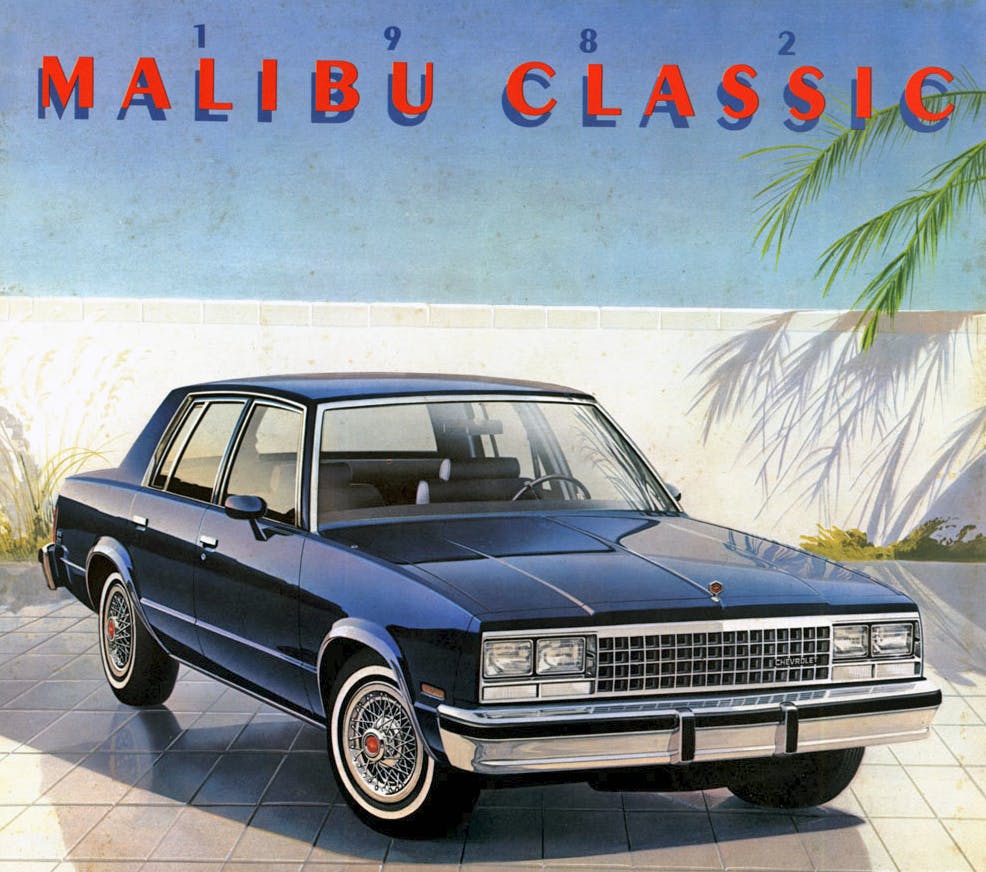The ’80s, or: Back when Celebrities were not cause for celebration
The early 1980s were no walk in the park for American automakers, even for those that had not declared bankruptcy in 1979. The forces that caused Chrysler to briefly go under weren’t unique to that company: increasingly worrisome foreign competition, R&D budgets stressed to lower emissions and improve safety, and an ever-present need to improve fuel economy via smaller cars with smaller engines. While the last was clearly needed after the onslaught of OPEC’s oil embargo in 1972, fuel economy was not always top of mind for customers.
Take, for example, the events in 1979 that threatened serious ramifications for gas prices but turned out to be less of a problem than we had feared. Unfortunately, automakers don’t have crystal balls, and turning their respective ships to make the vehicles demanded by the market takes a lot of time. Gas prices may fluctuate at speeds Wall Street can appreciate; supply chains are long and product development takes years.
This is the environment, however misinformed, that influenced Detroit to focus on downsizing operations, right-sizing its vehicles, and front-wheel-driving famous model names in its portfolios. Take Chevrolet’s mid-size lineup from 1982 to ’83: There were two platforms, one a brand new front-wheel drive (FWD) design, the other a rear-wheel-drive (RWD) platform downsized just a few years ago. Timing is everything, but time wasn’t on Chevy’s side: In GM’s alphabet soup of naming designations, both FWD and RWD mid-sizers were called “A-bodies.”

Since the FWD A-body was new, Chevy gave it a new name: Celebrity. This yet-to-be-famous Celebrity had the latest technology derived from GM’s X-body and even computer-assisted design to ensure it would perform better than the competition, which generally lacked General Motors’ impressive R&D budget. The Celebrity boasted new engines, aerodynamic designs, and advancements in NVH engineering—in short, a lot of money was on the line.
The RWD A-body was the polar opposite, tracing its roots to decades of successful, famous, and ultimately desirable vehicles from GM’s past. Chevrolet gave it an appropriately vintage name: What was once a Malibu became a Malibu Classic. (Oldsmobile did the same via Cutlass to Cutlass Supreme, Pontiac went from Lemans to Bonneville G, and Buick turned the Century into a Regal.) But most of the A-body DNA that traditionalists adore was filtered out by Malaise Era engineering upgrades, including anemic V-6 engines and side windows that rear-seat occupants couldn’t roll down. No matter, guess which one still had a lot of pull, thanks to gas prices that did the opposite of what we were anticipating?

This photo from the 1982 Chevy Malibu Classic’s sales brochure says it all. Why have front wrong-wheel drive and a unitized body when rear-wheel drive and a ladder-type frame work better in many North American zip codes? Clearly, the GM brotherhood was failing, as there was too much competition within Chevrolet. What was needed was a unified force to fight external threats.

But wait, the situation gets worse. Not only was the Celebrity fighting the Malibu Classic, but it also had an infighting problem. With one deliciously tragic photo, this Fortune magazine cover proved the similarities between the Celebrity and its sister ships from Pontiac (6000), Oldsmobile (Cutlass Ciera), and Buick (Century). While the A-body attributes were worthy of individual consideration, the disastrous change of guard at General Motors’ design studio made it much harder to cross-shop GM brands on anything but price.
That’s not to say the Celebrity (and all of GM’s new A-bodies) weren’t well-designed vehicles. I remember our family renting a Celebrity in the mid-1980s, and we liked the interior quality, ride, handling, and acceleration. That 2.8-liter Chevy was head and shoulders above the rear-wheel-drive, A-body, V-6-powered Buick Century and the Chevy Monte Carlo in our family’s garage. (Yes, the Monte is technically a G-body, I get it … don’t roast me in the comments.)
General Motors was playing damage control during this time, and its mea culpa wasn’t lost upon the fine folks at Motorweek when it drove the 1983 Chevrolet Celebrity CL coupe. In its sophomore year, the Celebrity performed well in Motorweek‘s road test, with a quiet ride and tolerable acceleration, thanks to the three-speed slushbox. However, the nervous handling and braking meant a few tweaks were still needed.
The Malibu Classic still had merit at the time, especially if dealership discounts/haggling lowered its price to a figure that belonged to the RWD A-body’s heyday. To be fair, discussing the Celebrity and Malibu Classic in some sort of A-body deathmatch some four decades later is a trite yet boring path to Middle Class Fancy commentary. I imagine something similar could be said about the Ford Edge vs. Fusion in another 40 years. Isn’t it wonderful to have 20/20 hindsight while wearing rose-colored glasses?

All non-Celebrity GM A-bodies were updated in 1989 for more passenger space and a sleeker rear window, but none could hold a candle to the W or N platforms, introduced in the ’90s, in terms of modern style. But look at the prices above: The A-body was still a convincing value proposition. Imports from Honda and Toyota were usually threats at the higher end of the market (i.e. high demand, infrequent discounting), and the Cutlass Ciera and Buick Century completed the squeeze at the other end. While the A-body of the 1990s was outdated (especially its interior design), GM still thought there was a market for the cars until 1996.
Or perhaps the powers that be at the Oklahoma City assembly plant had some leverage on the management types on GM’s Fourteenth Floor? We may never know the truth of the matter, but there’s no doubt that the FWD A-body was the best of the new GM … until it became the worst of old GM.
***
Check out the Hagerty Media homepage so you don’t miss a single story, or better yet, bookmark it. To get our best stories delivered right to your inbox, subscribe to our newsletters.





Here is the truth on the A Bodies.
Was not a great car but was better than many others of that era.
They got decent mileage. They were reliable, cheap to repair, easily run 200,000 miles.
Look few cars were bright spots in this era. But to compare this car to a K cor or any other Chrysler of the era it was like a Rolls Royce. The Tempo and Taurus also decent cars but far from perfect.
As for the Honda, Toyotas and Nissans of the era. Here in the mid west they were not cheap to fix or long lived due to rust.
The weak spot of the A body was the 4 cylinder. Under powered and leaked oil. The 2.6 had a good track record of few issues. It was smooth and ran well.
My parent had two celebrities and both lasted 100k miles with no issue. They also had an Old Ciera and while it was for sure my fathers olds never had an issue.
The truth is the 70’s were the dark ages and when the 80’s arrived with new technology we stated to see more power and better handling. It was just the start as it never fully arrived till the 90’s.
These cars started to give us some hope that things would get better. The Mustang and F. Body told us all was not lost.
The Celebrity became a staple of school parking lots in the 90’s as it was affordable, reliable and cheap to repair. High school kids drove these for years.
The 2.5 Iron Duke and the 2.8 V6 were not much to write home about, nor was the 3 speed automatic. How a sub 100 hp 4cylinder could have so much torque steer is really impressively bad. We didn’t own a Celebrity, but family did.
We had both, a RWD A/G-body and a Fwd Abody. The ONLY thing better about the front driver was the 3.8 Buick FI V6 (1985), vs the Carb’d 3.8 Chevy V6.
Otherwise, the a body lasted about 4 years before it fell apart, the subsequent GM10 dumpster fire kept puking 3.1 V6s under warranty, until the warranty expired and it did it one more time – lasted 5 years, only to be replaced by a proper large Buick.
That late Malaise A/G body lasted 10 years, thanks to some teen overlap, before getting totaled. It was always amazing to me that Midwest rural folk would have an older rear drive mid or fullsized GM product in service and a broken front driver parked next to the barn. Aside from the 85 and newer Olds 88 and Buick LeSabre, GM FWD cars of the era were pretty lousy.
I’ll be honest, much of GM decisions from the late 70s into the 80s permanently damaged ALL of the brands. Less lousy than the competition is hardly a badge of honor.
In the book about “The Peter Principle” the catch phrase was “We’re no worse than everybody else.” Just make your product slightly better and you will get all the business.
This is one of those nondescript cars of the era that I always wondered if it would survive into collectordom.
No it would never be a collectable. Not rare and nothing special. Durable and cheap to drive and repair but that is not what drives collectors.
There was one limited edition and it is unknown.
The STE Pontiac version was the most interesting with AWD etc. But even they are largely unknown and they were not cheap to repair.
Most 80’s cars are difficult to restore due to all the plastic. Much of it is faded and damaged and nor reproduced. Trim parts are expensive NOS if you can find them.
Only a hand full of car will see collectors status. Most will be unrestored. Corvette F bodies, Mustangs, Fiero and Shelby cars are about the only ones that will see much growth.
The trucks will show more interest than the cars.
Contrary to what you think, these cars are indeed reaching collectible status! A couple of weeks ago I attended the annual show for the group “Classic GM FWD Society”, and I can assure you, people are indeed collecting and caring for, these 80’s GM front drive cars.
That’s right! I live in Poland and I own 1982 2.8 Celebrity CL and 1987 3.8 “Red dot” Lesabre Limited Coupe. Even in Europe people started to value fwd GM cars. 🙂
Bought one new in 1985 the day after I took an engineering job at GM, and moved to Flint. (two days before I was ready to drive 50 miles to pick up my hard to find Honda Accord not a good plan with the move to Flint) Never saw one like it. 4 door Celebrity, console floor shift, Had a giant badge on the the back that said 2.8l V6 multipoint fuel injection. 4 speed auto trans (GM440). Never let us down but it surged so much felt like a rubber band was in the drive train. Sold it in 1987 to a 90 year old guy…who died and his 70 year old son drove it for the next 5 years!
Had a growing family so we bought a LeSabre (since I now worked for Buick) Went on to be part of the N cars with Buick. 86 was the bottom for powertrain quality, by 87 the 440 was solid, the 3.8 and 3.3 V6’s were nearly bullet proof. The real shocker was how GM, who use to lead in styling, made bland cars for over 15 years…teetering on bankruptcy can do that to a company.
I had an ’82 Olds “Cutlass” 4 door A body, an ’84 Pontiac 6000 STE, and an ’87 LeSabre coupe, some sort of “brass hat” corporate order with a flashy grey/black interior. All rock solid cars, considering the dreck from the 70’s. Loved the relative performance from the V6’s, but all needed bigger / better brakes. I drove 40K / year in-town for a sales job and replaced front pads every other oil change, it seemed.
In 1980 I changed jobs and covered Alberta, Saskatchewan and the Northwest Territories. The new company provided a company car: first 2 years was a plain Jane Chevy Caprice with great comfort and performance. Company belt tightening meant next 2 years was a V6 Malibu. Pretty good comfort and rear wheel drive handling, much preferred when driving on gravel roads as some of my clients were pipeline construction and mining. Next 2 years we all got stuck with Celebrities which were junk compared to the Malibu. Driving fast on gravel roads was absolutely treacherous with front wheel drive., and by the time it was two years old was
rattling everywhere. My dealers sales reps were also stuck with Celebrities. A dozen of us would be in the company parking lot after a sales meeting, popping our hoods open and using a pen to prop open the choke so the damn cars would start since they would vapour lock on warm days. Next 2 years I demanded a Taurus instead. Much better in gravel or snow, and two years later still felt like new. But the company had fallen for the “free air conditioning but only on 4 cylinder models”. I loved the car, but hated the absolutely gutless 4 cylinder that would try to upshift then downshift every 100 yards driving in the mountains. Next my girlfriend and I bought a new Chrysler Intrepid……. WOW what an improvement in comfort and handling. And yes, all the Japanese cars bragged about their mythical quality while they completely rusted in no time. People with nice cars were buying 2 year old Toyotas as winter beaters for $500 since they were such rust buckets but mechanically ok.
I was a courier for a clinical lab from 1982 to 1985. When I started the job there, the fleet was mostly made up of 1982 Cavalier coupes. They were pretty miserable cars. I think part of the reason for that was that ’82 was the first year for them. Those Cavaliers were replaced, in 1984, mostly with Celebrities. Us drivers thought we’d died and gone to heaven. In other words, many things in life are relative. In other, other words, the Celebrities were not that bad, actually pretty nice. Relatively speaking.
Our one and only foray into GM ownership (after 20 years of imports) was an 85 Century with a crypto-Bosch fuel injected V6. No HP but lots of torque. Can’t say too much bad about the drivetrain (although the transmission failed at 64k miles, just after we sold it) but the paint started to fail at 18 months, and it had electrical gremlins the dealer never could find. After 5 years of badgering Buick to make good on the paint (this was GM’s first foray into water based paint), a letter from the VP of Buick essentially said, “we don’t care if you buy another Buick, we’re not gonna fix your paint.” We took their advice and bought an Accura Legend, still running and looking like new after 16 years and 147k miles. And GM wondered how/why they lost market share.
Anyone remember the time those cars were at the top of the “Most stolen” list? I think the Accord eventually took them over.
I remember theses things as hot garbage. Nothing about them would make me want them.
I worked at a Chevrolet Dealership 1987 – 1993 and remember prepping a bunch of Celebrity Eurosport and Eurosport VR Wagons and 4 Doors. For perspective, the Eurosport was the Z28, and the Eurosport VR was the IROC version of the Celebrity line, just like the Cavalier Z24. The Eurosport VR was released right before the Beretta and Corsicas were introduced, and like the 88 Beretta GTU and 89-up GTZ, they could only be ordered in limited colors. Red, White and Black for the Eurosport VR but if my memory still serves me, the non-VR Eurosport was also available in Metallic Blue and Silver. The VR came with the 3.8 EFI, had a solid plastic grille filler that was body colored with a big Red Bowtie in the center, red emblems everywhere else, the window trim and the headlamp fillers were black (the rest of the Celebrity line still used chrome). The Eurosport didnt have the grille panel (but had the same emblems and trim blackout) and the black body side molding had a red stripe (Celebrity had chrome stripe). The VR used a body colored molding with a red stripe that was part of a lower body ground effects kit. VR also had specific 5 spoke aluminum wheels that were body colored and I think had Goodyear Eagles from what I remember. The Eurosport and VR had a cloth velour interior trim option that wasn’t available on other Celebrity models which had a red stitching in the pattern. One night after hours I ran a brand new VR wagon against a co-worker in a new Monte SS Aerocoupe demo the dealer had in 1988, and the VR was a fender ahead of the SS for the first 300 feet. After that it was just SS taillights getting smaller and smaller. They were definitely a reflection of automotive styling during the time they were built but I haven’t seen a VR since 1989 or so and only a handful of Eurosports since then.
You raise an interesting issue about GM pursuing a product approach with a dual focus. It’s important to remember that Roger Smith, often maligned as a “bean counter”, was running the company. At that point, the rear drive cars’ costs were pretty well amortized and we’re really cash cows as Smith attempted to develop fuel efficient cars and more importantly car’s competitive with imports. The productive capacity was there and paid for for the rear drive platforms. Not so for the front wheel drive lines and what would be necessary to address fuel efficiency targets and to fend off the Japanese. The Saturn results from that effort but didn’t really fulfill the mission. And what followed was a floundering giant that lost its way, right into bankruptcy.
GM is on a similar bent right now. Mary Bara, in discussing the UAW demands and GM’s fiscal priorities, has stated recently that truck revenue is the “cash cow” for further development of EVs. Again, the production infrastructure is there for ICE vehicles but still a sizable challenge for alternative fueled vehicles. It looks like she is borrowing from past practice.
I had a 1985 Chevy Celebrity Eurosport Wagon in charcoal. I loved it and always got compliments on its looks. (My only regret is when I ordered it I should have opted for the bucket seats and automatic floor shift.).
I had a Celebrity 2.8 Litre as a company car in the later half of the 80’s. It blew the doors off of the other cars in our fleet (mostly Malibu Classics) for ride quality, power and overall feel but then again, my previous company car was a Chevette… My daily driver at the time was a Honda CRX which felt like a real sports car after stepping out of the company car.
Drove both as company cars. Malibu was tolerable, but the Celebrity ……. Suffice it to say, it didn’t have enough power to get out of its own way, and the seats make my back hurt just thinking about them. Best day of ownership was when the company switched the fleet to Taurus/Sable.
I may be the odd man out here but I was a fan of the GM A body cars. When properly equipped with the fuel injected 2.8 V6, the 4 speed automatic and the F41 sport suspension, they were a pretty darn nice car for their day. I owned an 87 Pontiac 6000 SE (the cheap version of the STE) that would carry my family, was comfortable, sporty for the day and reasonably economical. When my 16 year old daughter put it into the ditch at around 55 mph, flew it through the air into a tree and landed upside down, all 4 young occupants escaped with only minor injuries. Since that was not enough for the young man who later became my son in law, he took another Pontiac 6000, fell asleep at the wheel and put that one on it’s roof in the middle of the highway and again walked away. I have only fond memories of these cars. For their time, they were good stuff.
our family had a 3.6 86 celebrity station wagon from new. Drove it for years then passed it on to our oldest son who drove it several more years. An attractive darker gray with light interior, ran well, performed well enough and reliable!